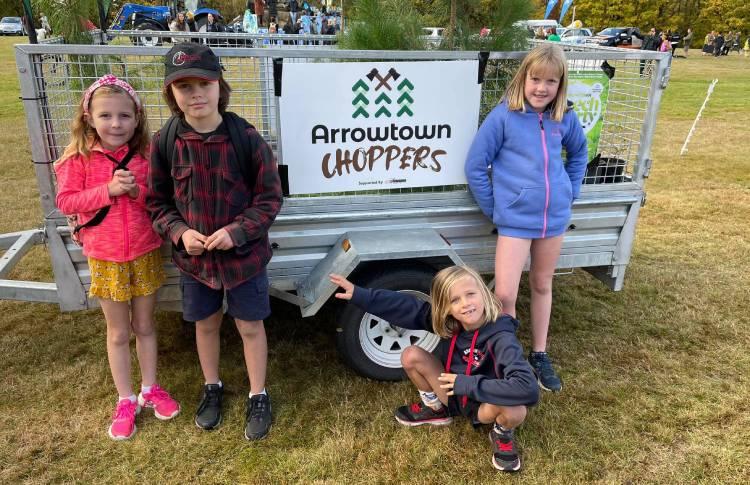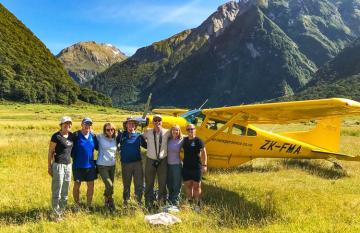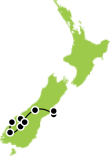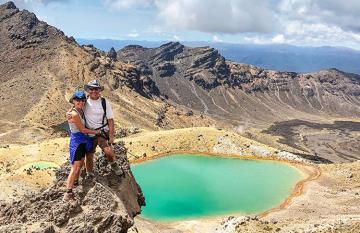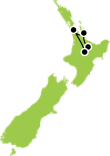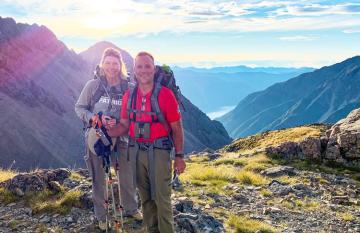
Without large-scale funding and control within twenty years 20% of New Zealand will be covered with wilding pines. As wilding conifers spread across our landscapes they: reduce the numbers of plants and animals that are only found in New Zealand.

Q: What are 'Wilding Pines'
A: Wilding pines are trees which have self-seeded and are growing where they are not supposed to be - they are the wrong tree in the wrong place. Unlike commercial forests, wilding pines are weeds. In fact, wilding pines are the plants which pose the biggest threat to New Zealand’s unique environment. They are as much of a menace to our environment as stoats, rats and possums.
Q: Why wildings are a problem
Wilding pines overwhelm our native landscapes, killing native plants and forcing out native animals.
They grow very densely - taking the sun, water and nutrients other plants need. Unlike native New Zealand bush - where a wide variety of species exist together - wilding pines produce forests which largely support only other wilding pines. Native plants and animals are forced out.
Once wilding pines start to produce cones, the seeds within them are quickly and effectively spread by the wind. This leads to a rapid increase in the number of trees. The increase in the number of trees means more seeds and so the area of land infested by wilding pines increases very rapidly. Wildings have rapidly infested New Zealand since the 1970s.
Wildings also force out other species
They grow so fast, they rapidly overwhelm native and productive species. Wilding pines take the sunshine, water and nutrients other plants need to grow and then quickly become the dominant species. The loss of native plant species means that native animals, like kereru, which feed on these native plants, are also forced out. We must act now and remove wilding pines to protect New Zealand’s unique natural environments and regional economy.
Q: Where do wilding pines come from?
A: Wildings are the wrong tree in the wrong place. Unlike commercial forests, wilding pines are weeds. They are self-seeded and not intentionally planted. Once they get established, wilding pines spread quickly. Within 3 decades, more than 25% of New Zealand could be covered by wilding pines unless we control the problem. We must act now, before the problem becomes too big. Every year we wait, the cost of removing wilding pines rises by 30%. We must remove wilding pines to protect New Zealand’s unique natural environments and regional economy.
Q: What parts of New Zealand are threatened by wilding pines?
A: Around 1.8 million hectares of New Zealand’s unique natural environment is known to be infested with wilding pines. This includes some of our most iconic landscapes like Mt Tongariro, the Coromandel, the MacKenzie Basin, and Kai Iwi Lakes in Northland. Also seriously at risk are areas with low-growing native plant communities such as geothermal areas, alpine areas and coastal communities, as wilding pines quickly shade these out, forcing these species out.
Q: What can be done to control wilding pines?
A: We can control the spread of wilding pines. The National Wilding Conifer Control Programme aims to bring New Zealanders together to tackle this significant national problem, including central and local government, local communities, researchers, industry and private landowners. The programme has already protected 3 million hectares, or just over 11 %, of New Zealand’s most vulnerable land.
If we do nothing, research predicts we will lose up to 7.5 million hectares of New Zealand to wilding pine invasion. This could have an economic cost of $4.6 billion, due to the negative impact of wilding pines on primary production, biodiversity, hydroelectrical power generation and irrigation. We must act now and remove wilding pines to protect New Zealand’s unique natural environments and regional economy.
Q: What is First Light Travel doing about it?
A: We are supporting the grassroots community action group the 'Arrowtown Choppers' (as in tree choppers) This is a grassroots project supported by the Arrowtown local community and local businesses including First Light Travel and New Zealand Trails. The project is a significant part of our strategy as a tourism business to offset carbon emissions and contribute to New Zealand's natural beauty!
As the forest develops, the carbon captured in the trees and soil will help offset our carbon dioxide emissions. The current plan is to plant and nurture over 100,000 seedlings for the foreseeable future. Volunteers will plant around 5000 trees per year. This collaboration represents a novel approach to reforestation and education, where the indigenous biodiversity of the land will be restored while providing a range of benefits to the community.
Join us on the journey of reducing our environmental footprint.
First Light Travel and our sister company New Zealand Trails acknowledge that we need to reduce our environmental footprint. Our carbon measurement and offset program to date has allowed us to plant over 3000 native beach trees.
First Light Travel is the Major Sponsor of the Arrowtown Community Tree Nursery (set up by the Arrowtown Choppers) - ensuring that we can supply beech seedlings with the highest chance of survival due to local acclimitisation.
Beech trees (Nothofagus species) can sequester a significant amount of carbon over their lifetimes. A mature tree can store about 22 kg of CO2 per year on average.
You can opt-in and help for as little as $NZ5pp (US$3) - or not, it's ok, we are going to do it anyway. This year we donated $NZ10,000 (that's 3,333 seedling beech trees) and volunteered with planting - and we intend to do better next and every other year.
Read more about our carbon offset program here.
Recent Posts
Blog Categories
Blog archives
- April 2025 (2)
- February 2025 (3)
- January 2025 (6)
- December 2024 (12)
- November 2024 (3)
- October 2024 (2)
- July 2024 (2)
- May 2024 (12)
- April 2024 (2)
- March 2024 (2)
- January 2024 (2)
- November 2023 (10)
- October 2023 (4)
- August 2023 (1)
- May 2023 (2)
- April 2023 (2)
- March 2023 (17)
- February 2023 (4)
- January 2023 (4)
- December 2022 (11)
- November 2022 (7)
- October 2022 (1)
- May 2022 (1)
- March 2022 (3)
- February 2022 (3)
- January 2022 (1)
- December 2021 (1)
- August 2021 (1)
- June 2021 (1)
- May 2021 (2)
- February 2021 (1)
- August 2020 (1)
- July 2020 (1)
- May 2020 (1)
- April 2020 (1)
- March 2020 (1)
- January 2020 (1)
- December 2019 (1)
- November 2019 (1)
- October 2019 (1)
- September 2019 (1)
- August 2019 (5)
- July 2019 (2)
- June 2019 (1)
- May 2019 (3)
- April 2019 (1)
- March 2019 (1)
- February 2019 (1)
- January 2019 (1)
- December 2018 (1)
- November 2018 (1)
- September 2018 (1)
- August 2018 (1)
- July 2018 (1)
- June 2018 (1)
- May 2018 (1)
- April 2018 (1)
- March 2018 (1)
- February 2018 (1)
- January 2018 (1)
- December 2017 (1)
- October 2017 (1)
- September 2017 (1)
- August 2017 (1)
- July 2017 (1)
- June 2017 (1)
- May 2017 (1)
- April 2017 (1)
- March 2017 (1)
- February 2017 (1)
- January 2017 (1)
- December 2016 (1)
- November 2016 (1)
- October 2016 (1)
- September 2016 (1)
- August 2016 (1)
- July 2016 (1)
- June 2016 (1)
- May 2016 (1)
- April 2016 (1)
- March 2016 (1)
- February 2016 (1)
- January 2016 (1)
- December 2015 (1)
- November 2015 (1)
- October 2015 (1)
- September 2015 (1)
- August 2015 (1)
- July 2015 (1)
- June 2015 (1)
- May 2015 (1)
- April 2015 (1)
- March 2015 (1)
- February 2015 (1)
- January 2015 (1)
- December 2014 (1)
- November 2014 (1)
- October 2014 (1)
- September 2014 (1)
- July 2014 (1)
- June 2014 (3)
- May 2014 (1)
- April 2014 (1)
- March 2014 (1)
- February 2014 (1)
- January 2014 (1)
- November 2013 (15)
- October 2013 (1)
- September 2013 (1)
- August 2013 (1)
- July 2013 (1)
- May 2013 (1)
- April 2013 (1)
- March 2013 (1)
- February 2013 (1)
- January 2013 (1)
- December 2012 (1)
- November 2012 (2)
- October 2012 (2)
- September 2012 (2)
- August 2012 (2)
- July 2012 (2)
- June 2012 (2)
- May 2012 (2)
- April 2012 (3)
- March 2012 (2)
- February 2012 (2)
- January 2012 (2)
- December 2011 (2)
- November 2011 (1)
- October 2011 (2)
- September 2011 (1)
- August 2011 (1)
- July 2011 (1)
- June 2011 (1)
- May 2011 (1)
- April 2011 (1)
- March 2011 (1)
- February 2011 (1)
- January 2011 (1)
- December 2010 (1)
- November 2010 (1)
- October 2010 (1)
- September 2010 (1)
- August 2010 (1)
- July 2010 (1)
- June 2010 (1)
- May 2010 (1)
- March 2010 (1)
- February 2010 (1)
- January 2010 (1)
- December 2009 (1)
- November 2009 (1)
- October 2009 (1)
- September 2009 (1)
- August 2009 (1)
- July 2009 (1)
- June 2009 (1)
- May 2009 (1)
- April 2009 (1)
- March 2009 (1)
- February 2009 (1)
- January 2009 (1)
- December 2008 (1)
- May 2005 (1)


